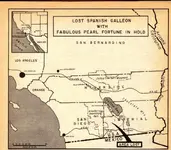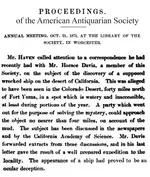Hi there "Isayhello". No, 1920s is not late arrivals for that part of the desert. Aside from travelor stop spots, there wasn't much of anything before the 1910's down there. All those towns got their start just after the turn of the century, at the earliest. The reason is, it gets to friggin 120* at times, esp. before the Salton Sea, and irrigation got going to cool things down a few degrees (Now it only tops out at 115*!). Can you imagine living there before air conditioners? Before there was electrical power, to power "swamp coolers", it was only a hardy few that lived down there, if any. Swamp coolers were later replaced by conventional air conditioner technology in later years. But anyhow, in the late 1920s, when my granfolks arrived, those towns were scarcely 25 yrs. old then. So no, they weren't late arrivers. And sorry to say, the lost ship story was just fancied tall tales.
I've read somewhere that the time-line for the inland sea story, that that was shallow sea up till 1600, is off. It had receeded long before that, in historic time. So I guess to beef up the story, story tellers add: In a
storm, at
high tide, that pushed waters
way up to what is now the desert... blah blah.... (to promote the possibility that it was could've happened). We're talking 100+ miles here folks. If water got that high, as recently as 1600, you could merely do a study to see how much higher ocean levels would have to be (ie.: how high is the land, before dropping back down to below sea level @ Brawley/El Centro area). Now take whatever # of feet that is, and see how that would affect the rest of the world's sea fronts? I mean, certainly there are European coastal front communities who have historical reference points going back much older than that, that sea levels can be measured from (1600 is relatively recent, in terms of world history). And don't forget you have to add at least 10 more foot of depth (?), to account for the depth the ship would need to keep floating along.
And to show that old maps showed CA as an island, is not conclusive. Let's face it, mapmaking was poor in those days. They just merely mistook the Colorado River as going up and up and up. Or, they just saw the gulf of CA, and just assumed it kept going and going. Heck, spots on maps all over the world were innacurate in those days. They were full of conjecture and mistakes. It proves nothing.
Sure, maybe there was a lost pearl ship, but I doubt it's anything but at the bottom of the current gulf of Mexico, or Pacific somewhere, or who knows.
PS: My grandma is still alive down there at 96. Probably one of the last of the area inhabitants that can still recall life down there in the 1920s. She moved there as a 19 yr. old bride

I've gotten coins back to barbers and IHs there in parks in those towns.






 I've gotten coins back to barbers and IHs there in parks in those towns.
I've gotten coins back to barbers and IHs there in parks in those towns.


